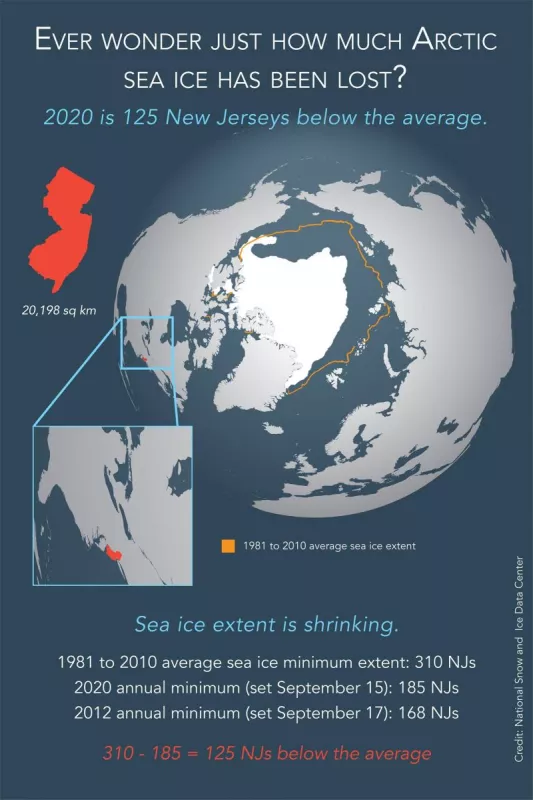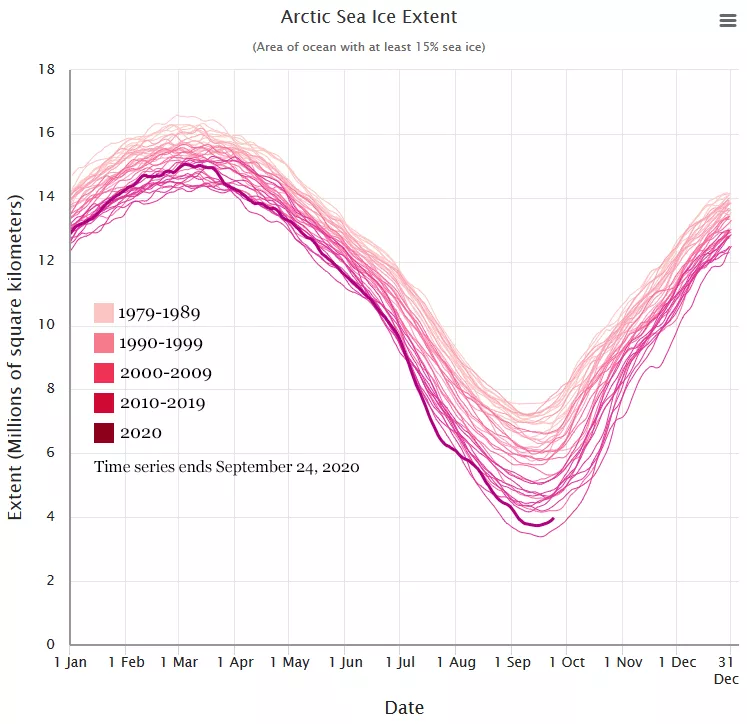Despite year-to-year variability, Arctic sea ice has steadily dropped during all seasons since the start of the satellite record in 1979. However, the changes are especially pronounced around the time of the sea ice minimum in September, when sea ice extent has declined by about 13 percent per decade.
To put the loss into perspective, the following examples compare minimum sea ice extents to a percentage of the contiguous United States. From 1981 through 2010, the minimum extent averaged 6.33 million square kilometers (2.44 million square miles), an area equivalent to 78 percent of the contiguous United States. From 2010 through 2019, the minimum extent averaged 4.49 million square kilometers (1.73 million square miles), or 56 percent. The record minimum, reached on September 17, 2012, covered only 3.39 million square kilometers (1.31 million square miles), or 42 percent of the contiguous United States.
Arctic sea ice volume has dropped just as dramatically. In the early years of the satellite record, average sea ice thickness in August stood at well over 2 meters (6 feet). As of August 2020, average volume was barely above 1 meter (3 feet).
Arctic sea ice 101
Sea ice, or frozen seawater, floats on the ocean surface. Year after year, sea ice in the Arctic and Antarctic waxes and wanes with the seasons, growing in the fall and winter, and melting in the spring and summer. Earth’s seasonal differences are most pronounced near the poles, so the differences in winter and summer extents are significant.
Since ocean temperatures lag behind atmospheric temperatures, both in warming up and cooling down, sea ice reaches its maximum and minimum extents well after the winter and summer solstices. Sea ice expands during the dark, frigid Arctic winter, reaching a maximum extent in March. Come mid-April, the midnight sun rises and does not set until mid-August. Typically, sea ice reaches its minimum extent in September.
A decades-long decline
Although Arctic sea ice continues its annual cycle of growth and melt, as of September 2020, ice extent was declining in all months, with the steepest rates of loss occurring around the time of the September minimum. So although Arctic sea ice continues following its annual roller coaster trajectory—starting high in January, climbing until March, melting until mid- to late September, then climbing again through the rest of the year—that roller coaster now runs at lower elevations.
Researchers who study climate and sea ice expect that at some point the Arctic Ocean will lose its ice cover in late summer. Ice free, however, does not mean zero ice cover. When sea ice extent drops below 1 million square kilometers (386,000 square miles), or the equivalent in size to Texas and Arizona combined, scientists consider this to be an ice-free Arctic.
Arctic sea ice is declining because increased greenhouse gases in the atmosphere are warming Earth’s climate. Since these gases persist and are expected to increase, scientists see no reversal of the downward trend in ice extent. Climate models have long predicted that Arctic sea ice loss would accompany warming temperatures in the Arctic. But the ice loss has happened faster than any models predicted, and researchers now expect that the Arctic Ocean will be ice free in summer before the end of the 21st century, with some predictions as early as 2030.
References
NSIDC. 2020. Sea ice index. https://nsidc.org/data/seaice_index/
NSIDC. 2020. Charctic. https://nsidc.org/sea-ice-today/sea-ice-tools/charctic-interactive-sea-ice-graph
Labe, Z. 2020. Arctic Sea Ice Figures. https://zacklabe.com/arctic-sea-ice-figures/

